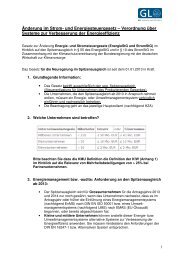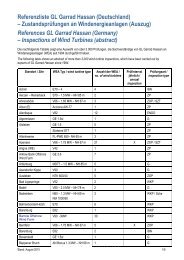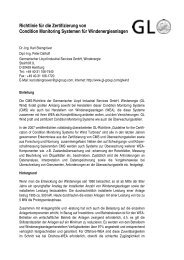Protection of Fuel Tanks Safety ahead! - GL Group
Protection of Fuel Tanks Safety ahead! - GL Group
Protection of Fuel Tanks Safety ahead! - GL Group
You also want an ePaper? Increase the reach of your titles
YUMPU automatically turns print PDFs into web optimized ePapers that Google loves.
Cool Transport<br />
The shipping <strong>of</strong> perishable goods in refrigerated containers is booming. Sophisticated<br />
refrigeration and ventilation systems inside the vessels help to reduce operating costs<br />
ASalmon from Alaska, lamb from New Zealand, bananas<br />
from Honduras: the food on dining tables in Germany<br />
and elsewhere has <strong>of</strong>ten travelled thousands <strong>of</strong><br />
nautical miles. According to statistics from Drewry Shipping<br />
Consultants, 57.1 million tons <strong>of</strong> refrigerated cargo<br />
were shipped across the seven seas in 2005 – more than<br />
twice much as 25 years ago.<br />
The bulk <strong>of</strong> perishable goods is now transported in refrigerated<br />
containers – which poses a big challenge for designers<br />
and shipbuilders alike: if the refrigeration units<br />
in the containers are to work efficiently, cool air must be<br />
pumped into, in particular, the ship’s hold and the warm<br />
air pumped out.<br />
Germanischer Lloyd’s new simulation system enables<br />
ship designers and shipyards to construct effective ventilation<br />
systems for any ship type. <strong>GL</strong> Vent simulates different<br />
operating, load distribution and temperature situations.<br />
The s<strong>of</strong>tware provides the necessary data for the installation<br />
<strong>of</strong> effective and economical ventilation systems and<br />
analyzes the weaknesses <strong>of</strong> fitted systems.<br />
Enormous Cost-Saving Potential<br />
Demand is growing. Although around half <strong>of</strong> all bananas<br />
are still being transported on reefer vessels, hardly any<br />
new vessels have been built for years, and the trend towards<br />
refrigerated containers is stronger than ever before.<br />
The annual transport capacities in this sector are now rising<br />
by 14% on average, which is even faster than the overall<br />
market for refrigerated cargo. Ten years ago, capacity was<br />
267,000 TEU; this figure has now reached 746,000 TEU.<br />
Currently there are 2200 vessels worldwide that transport<br />
CONTAINER. The<br />
refrigerating set needs a<br />
suffi cient ventilation.<br />
Source: Drewery Shipping Consultants<br />
refrigerated containers. The largest <strong>of</strong> these, the ‘Monte<br />
Cervantes’ owned by the shipping company Hamburg-Süd,<br />
has a total loading capacity <strong>of</strong> 5100 TEU, <strong>of</strong> which 2450<br />
TEU can be used for refrigerated containers.<br />
There are still two different container types in operation:<br />
integrated containers with an inbuilt refrigeration unit, and<br />
porthole containers without any additional refrigeration.<br />
However, most shipowners have gone over to using integrated<br />
containers. In 2002, the proportion <strong>of</strong> porthole types<br />
on the world market was less than five per cent.<br />
As for container loading capacities, the trend is towards<br />
a larger volume inside the container. Traditional 40-foot<br />
standard containers with a height <strong>of</strong> 8’ 6” are increasingly<br />
being replaced by high-cube containers (height: 9’ 6”).<br />
Nonetheless, 20-foot containers are still just as important<br />
as before. Heavy reefer cargo, such as meat and fish, would<br />
soon exceed the maximum weight <strong>of</strong> 30 tons if stuffed in<br />
larger containers.<br />
As the number, size and weight <strong>of</strong> refrigerated containers<br />
grow, they are increasingly being stowed in the ship’s<br />
hold rather than on deck. To make sure there is sufficient<br />
cooling, the ambient air temperature may not exceed 45 degrees<br />
centigrade. A 40-foot container requires 4,500 cubic<br />
metres <strong>of</strong> air per hour, and a 20-foot container needs 3,100<br />
cubic metres. This is because, depending on the goods and<br />
room climate, a stand-alone 40-foot container produces<br />
between 7 and 15 kW <strong>of</strong> heat. These values increase even<br />
more depending on how many boxes are in the hold.<br />
<strong>GL</strong> calculations prove the economic importance <strong>of</strong> sophisticated<br />
and optimized ventilation systems: if there are<br />
700 TEU in the ship’s hold and the ambient air temperature<br />
drops by one degree, the energy consumption <strong>of</strong> refrigerated<br />
containers with frozen cargo is reduced by 3.8 per cent<br />
and that <strong>of</strong> containers holding frozen fruit by 2.1 per cent.<br />
According to these calculations, the ship operators save approx.<br />
EUR 50,000 per year in the operation <strong>of</strong> their ventilation<br />
systems – and salmon, lamb and the rest are sure to<br />
reach their destinations in perfect condition. ■ JH<br />
For further Information: Hanspeter Raschle, Piping Systems/Tanker,<br />
Phone: +49 40-361 495 69, E-Mail: hanspeter.raschle@gl-group.com<br />
15<br />
10<br />
5<br />
0<br />
Bananas<br />
Meat<br />
Citrus fruit<br />
<strong>GL</strong> VENT | MARITIME SERVICES<br />
Development <strong>of</strong> refrigerated cargo transport<br />
millions <strong>of</strong> tons<br />
20<br />
Saisonal fruit<br />
Fish products<br />
Diary products<br />
nonstop 4/2006<br />
1981<br />
2005<br />
19

















